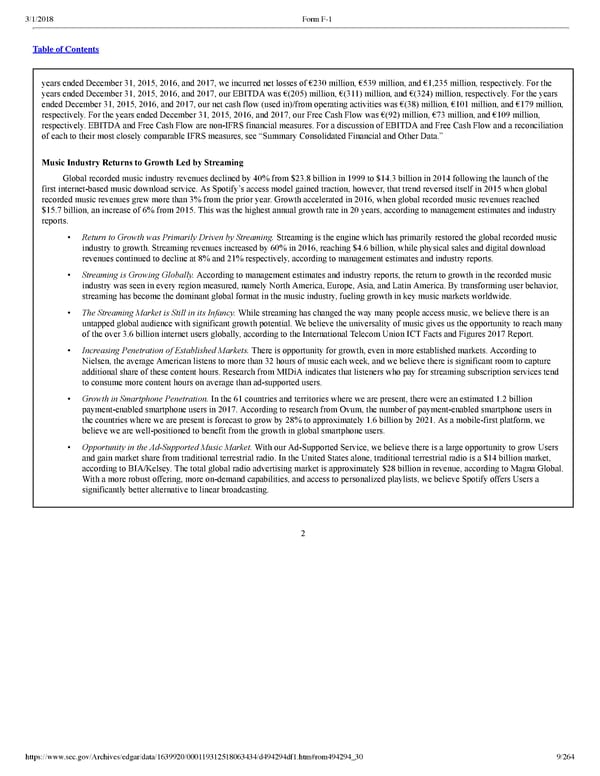9/264 years ended December 31, 2015, 2016, and 2017, we incurred net losses of €230 million, €539 million, and €1,235 million, respectively. For the years ended December 31, 2015, 2016, and 2017, our EBITDA was €(205) million, €(311) million, and €(324) million, respectively. For the years ended December 31, 2015, 2016, and 2017, our net cash flow (used in)/from operating activities was €(38) million, €101 million, and €179 million, respectively. For the years ended December 31, 2015, 2016, and 2017, our Free Cash Flow was €(92) million, €73 million, and €109 million, respectively. EBITDA and Free Cash Flow are nonIFRS financial measures. For a discussion of EBITDA and Free Cash Flow and a reconciliation of each to their most closely comparable IFRS measures, see “Summary Consolidated Financial and Other Data.” Music Industry Returns to Growth Led by Streaming Global recorded music industry revenues declined by 40% from $23.8 billion in 1999 to $14.3 billion in 2014 following the launch of the first internetbased music download service. As Spotify’s access model gained traction, however, that trend reversed itself in 2015 when global recorded music revenues grew more than 3% from the prior year. Growth accelerated in 2016, when global recorded music revenues reached $15.7 billion, an increase of 6% from 2015. This was the highest annual growth rate in 20 years, according to management estimates and industry reports. • Return to Growth was Primarily Driven by Streaming. Streaming is the engine which has primarily restored the global recorded music industry to growth. Streaming revenues increased by 60% in 2016, reaching $4.6 billion, while physical sales and digital download revenues continued to decline at 8% and 21% respectively, according to management estimates and industry reports. • Streaming is Growing Globally. According to management estimates and industry reports, the return to growth in the recorded music industry was seen in every region measured, namely North America, Europe, Asia, and Latin America. By transforming user behavior, streaming has become the dominant global format in the music industry, fueling growth in key music markets worldwide. • The Streaming Market is Still in its Infancy. While streaming has changed the way many people access music, we believe there is an untapped global audience with significant growth potential. We believe the universality of music gives us the opportunity to reach many of the over 3.6 billion internet users globally, according to the International Telecom Union ICT Facts and Figures 2017 Report. • Increasing Penetration of Established Markets. There is opportunity for growth, even in more established markets. According to Nielsen, the average American listens to more than 32 hours of music each week, and we believe there is significant room to capture additional share of these content hours. Research from MIDiA indicates that listeners who pay for streaming subscription services tend to consume more content hours on average than adsupported users. • Growth in Smartphone Penetration. In the 61 countries and territories where we are present, there were an estimated 1.2 billion paymentenabled smartphone users in 2017. According to research from Ovum, the number of paymentenabled smartphone users in the countries where we are present is forecast to grow by 28% to approximately 1.6 billion by 2021. As a mobilefirst platform, we believe we are wellpositioned to benefit from the growth in global smartphone users. • Opportunity in the AdSupported Music Market. With our AdSupported Service, we believe there is a large opportunity to grow Users and gain market share from traditional terrestrial radio. In the United States alone, traditional terrestrial radio is a $14 billion market, according to BIA/Kelsey. The total global radio advertising market is approximately $28 billion in revenue, according to Magna Global. With a more robust offering, more ondemand capabilities, and access to personalized playlists, we believe Spotify offers Users a significantly better alternative to linear broadcasting. 2
 Spotify F1 | Interactive Prospectus Page 8 Page 10
Spotify F1 | Interactive Prospectus Page 8 Page 10